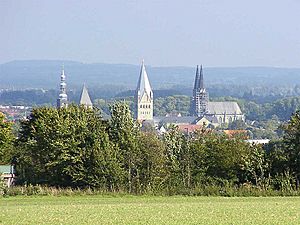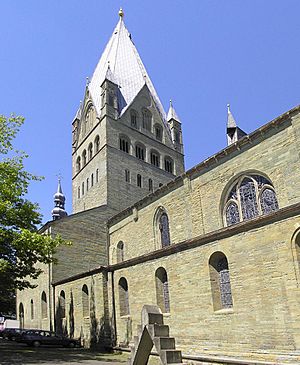Soest, Germany facts for kids
Quick facts for kids
Soest
|
|||
|---|---|---|---|

Soest
|
|||
|
|||
| Country | Germany | ||
| State | North Rhine-Westphalia | ||
| Admin. region | Arnsberg | ||
| District | Soest | ||
| Elevation | 90 m (300 ft) | ||
| Population
(2022-12-31)
|
|||
| • Total | 48,607 | ||
| Time zone | CET/CEST (UTC+1/+2) | ||
| Postal codes |
59494
|
||
| Dialling codes | 02921 | ||
| Vehicle registration | SO | ||
| Website | www.soest.de | ||
|
Imperial and Hanseatic City of Soest
Freie Hansestadt Soest
|
|||||||||
|---|---|---|---|---|---|---|---|---|---|
| 1449–1609 | |||||||||
| Status | Imperial, Hanseatic City of the Holy Roman Empire | ||||||||
| Capital | Soest | ||||||||
| Government | Republic | ||||||||
| Historical era | Middle Ages | ||||||||
|
• Mentioned in
Dagobertsche Schenkung |
836 |
||||||||
|
• Soest Feud to gain
Reichsfreiheit from Abp Cologne |
1444–49 1449 |
||||||||
|
• Annexed by
Brandenburg, with Cleves, on extinction of its ducal line |
1609 1609 |
||||||||
|
|||||||||
Soest is a city in North Rhine-Westphalia, Germany. It is the capital of the Soest district. Soest is known for its long history and beautiful old buildings.
Contents
Geography
Soest is located along an old trade route called the Hellweg road. It is about 50 kilometres east of Dortmund. It is also about 50 kilometres west of Paderborn.
Nearby Towns
Soest has several towns close by. These towns are:
- Bad Sassendorf
- Ense
- Lippetal
- Möhnesee
- Werl
- Welver
History of Soest
The area around Soest has very rich soil. People lived here long before the year 836. That's when the village was first mentioned in an old document. Even though the document's exact origin is unknown, we know people lived in Soest for a very long time. Digs have found signs of people living here over 4000 years ago!
Growth and Importance
In the 11th and 12th century, Soest grew a lot. It became one of the biggest cities in Westphalia. About 10,000 people lived there. Soest was also an important member of the Hanseatic League. This was a powerful group of trading cities in Northern Europe. Soest remained a member until 1609.
Soest's Fight for Freedom
From 1444 to 1449, Soest fought for its freedom. It wanted to be free from the Bishop of Cologne. The Bishop used to control Westphalia. This fight was called the Soester Fehde. Soest won its freedom, but it came at a high cost. The city lost much of its trade. This was because two-thirds of the "freed" town was surrounded by lands ruled by others.
When the last Duke of Cleves died in 1609, his land was taken by Brandenburg. After a short fight, Soest also became part of Brandenburg. During and after the Thirty Years' War, Soest lost many people. It also lost much of its power. At its lowest point in 1756, only 3,600 people lived there.
Modern Soest
Soest slowly started to gain influence again in 1817. This was when the Soest district was formed. However, the big growth of factories in the Ruhr Area did not reach Soest. It remained a smaller city.
From 1953 to 1971, many Canadian soldiers and their families lived near Soest. They were stationed in military camps. There were also Belgian military bases in Soest itself. Later, from 1971 to 1993, British military families used these areas. After the military facilities closed, some buildings were used for other purposes. Others were taken down. For example, old military housing became homes for regular families.
St Patroclus's Cathedral
In 960, Bruno I, Archbishop of Cologne moved the St Patroclus's relics (holy items). He buried them in 964 at St Patroclus's Cathedral in Soest. St Patroclus is still honored there today.
The Cathedral is a beautiful example of early medieval "Romanesque" architecture. This means it was built in an old, grand style. It is made from local greenish sandstone. Its large, square bell tower can be seen from many kilometers away. It stands tall in the center of the old city. It is a famous landmark of the Soester Boerde area.
Coat of Arms
The coat of arms of Soest shows a key. This key is a symbol for Saint Peter. Saint Peter was the patron saint of Cologne. The city's coat of arms did not change, even after Soest was no longer controlled by Cologne.
Twin Towns
Soest has friendly connections with several towns around the world. These are called twin towns:
 Bangor, Gwynedd, Wales
Bangor, Gwynedd, Wales Guérard, Seine-et-Marne, France
Guérard, Seine-et-Marne, France Herzberg, Brandenburg, Germany
Herzberg, Brandenburg, Germany Kampen, Overijssel, Netherlands
Kampen, Overijssel, Netherlands Sárospatak, Borsod-Abaúj-Zemplén, Hungary
Sárospatak, Borsod-Abaúj-Zemplén, Hungary Soest, Utrecht, Netherlands
Soest, Utrecht, Netherlands Strzelce Opolskie, Opole Voivodeship, Poland
Strzelce Opolskie, Opole Voivodeship, Poland Visby, Gotland, Sweden
Visby, Gotland, Sweden
Images for kids
See also
 In Spanish: Soest (Alemania) para niños
In Spanish: Soest (Alemania) para niños







